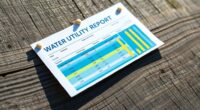Once your recyclables land in the blue bin, they’re taken to a facility where they’re unloaded onto conveyor belts for sorting. Advanced machines and workers work together to separate metals, plastics, and paper while removing contamination like food residues or non-recyclable plastics. The sorted materials are then compressed into bales and shipped to manufacturers, where they’re transformed into new products. Learn how proper sorting helps keep the process efficient and effective.
Key Takeaways
- Recyclables are unloaded onto conveyor belts and sorted using advanced machinery like magnets and air classifiers.
- Proper preparation by residents prevents contamination, ensuring recyclables are clean and easy to process.
- Contaminants such as food residues and plastic bags can cause delays, jams, or complete discard of loads.
- Sorted materials are compressed into bales and shipped to manufacturers for reuse in new products.
- Human workers and machines collaborate to maintain quality, with contamination removal being essential for efficient recycling.

Ever wonder what happens to your recyclables once they leave the blue bin? When you toss your bottles, cans, and paper into your curbside bin, they don’t just magically transform into new products. Instead, they head to a recycling facility where a process called single stream recycling takes place. This system allows you to throw all your recyclables into one bin, making recycling more convenient. But it also requires careful sorting to prevent contamination, which can seriously hinder the recycling process.
Once your recyclables arrive at the facility, they’re unloaded onto a large conveyor belt. Here, the first step is to separate different materials. The facility uses advanced machinery like magnets and air classifiers to quickly identify and sort metals, plastics, and paper. This automated sorting is indispensable for efficiency, but it also relies heavily on contamination prevention. For example, if food residues or non-recyclable plastics are mixed in, they can spoil entire batches, causing costly delays or forcing the facility to discard loads altogether.
Advanced machinery sorts recyclables, but contamination risks like food residues can cause delays or discard loads.
Contamination prevention begins with public education. You’re encouraged to rinse out containers and remove lids or other non-recyclable parts. The clearer your recyclables are of food or liquids, the easier it is for the facility to process them effectively. Once sorted, the materials are compressed into bales, shipped to manufacturers, and repurposed into new products. This cycle ensures that your recyclables don’t end up in landfills, reducing waste and conserving resources.
Throughout the process, workers and machines work together to ensure that only clean, recyclable materials move forward. Any contaminated items, such as plastic bags or greasy pizza boxes, are diverted or discarded. Plastic bags are particularly problematic because they can jam machinery, so many facilities ask residents to avoid bagging recyclables altogether. This is why contamination prevention is critical; it helps keep the entire recycling operation running smoothly and prevents costly breakdowns.
Understanding the importance of material sorting can help you better prepare your recyclables for pickup and processing. In short, your participation in single stream recycling and your efforts to prevent contamination play a crucial role in making the recycling process efficient. By understanding what happens after your recyclables leave the blue bin, you can see how important it is to prepare your recyclables properly. It’s not just about tossing items in the bin — it’s about making sure they’re clean and sorted correctly, so they can be transformed into new products rather than ending up in a landfill. Your small actions can have a big impact on the sustainability of your community’s recycling efforts.
Frequently Asked Questions
How Are Recyclables Sorted at the Facility?
You see recyclables arrive, and sorting technology kicks in to separate them efficiently. As you watch, plastic contamination is identified and removed to guarantee quality. Advanced machines use sensors and conveyor belts to sort materials by type and color, making the process quick and accurate. This technology helps prevent contamination, so only clean recyclables go to the next stage, ensuring the recycling process is effective and environmentally friendly.
What Contaminants Can Ruin a Batch of Recyclables?
Imagine a delicate balance, like a puzzle with missing pieces. Single stream contamination, such as food residues, and plastic sorting challenges can ruin a batch of recyclables. These contaminants make it difficult for machines to identify materials, causing delays and increased costs. When non-recyclables or dirty items sneak in, they spoil the entire load, jeopardizing recycling efficiency and harming the environment. Keep recyclables clean and dry to avoid these issues.
How Long Does It Take to Process Recyclables?
Processing recyclables generally takes a few days to weeks, depending on your local facility’s efficiency. During this time, contaminants are removed, and materials are sorted for reuse or manufacturing. To improve recycling outcomes, consider compost alternatives for organic waste and support recycling education initiatives. By understanding the process, you help reduce contamination, ensuring recyclables aren’t wasted and are transformed into new products efficiently.
Are There Any Recyclables That Can’t Be Recycled?
Think of recyclables as puzzle pieces; some don’t fit due to glass contamination or plastic segregation issues. You can’t recycle items like greasy pizza boxes or broken glass that contaminates other recyclables. Certain plastics, especially those with recycling codes outside accepted ranges, can’t be processed. Always clean and sort your recyclables properly to avoid issues, ensuring they can be transformed into new products instead of ending up as waste.
How Is the Quality of Recycled Materials Ensured?
You guarantee the quality of recycled materials through strict material quality control processes, which catch recycling contamination early. Regular sorting, advanced scanners, and manual checks help remove contaminants and non-recyclables. This way, the recyclables stay clean and valuable. By maintaining high standards, you prevent quality issues downstream, ensuring that recycled materials meet industry specifications and are suitable for manufacturing new products.
Conclusion
So, next time you toss your recyclables into the blue bin, remember—they might end up somewhere you’d never expect. Ironically, despite all your efforts to be eco-friendly, your carefully separated plastics and papers could be transformed into new products in ways you can’t imagine. It’s almost poetic—your small act of recycling has a big, surprising journey ahead. So keep recycling, because even the most unexpected endings can lead to a greener future.









